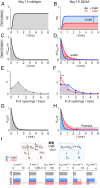Elementary mechanisms of calmodulin regulation of NaV1.5 producing divergent arrhythmogenic phenotypes
- PMID: 34021086
- PMCID: PMC8166197
- DOI: 10.1073/pnas.2025085118
Elementary mechanisms of calmodulin regulation of NaV1.5 producing divergent arrhythmogenic phenotypes
Abstract
In cardiomyocytes, NaV1.5 channels mediate initiation and fast propagation of action potentials. The Ca2+-binding protein calmodulin (CaM) serves as a de facto subunit of NaV1.5. Genetic studies and atomic structures suggest that this interaction is pathophysiologically critical, as human mutations within the NaV1.5 carboxy-terminus that disrupt CaM binding are linked to distinct forms of life-threatening arrhythmias, including long QT syndrome 3, a "gain-of-function" defect, and Brugada syndrome, a "loss-of-function" phenotype. Yet, how a common disruption in CaM binding engenders divergent effects on NaV1.5 gating is not fully understood, though vital for elucidating arrhythmogenic mechanisms and for developing new therapies. Here, using extensive single-channel analysis, we find that the disruption of Ca2+-free CaM preassociation with NaV1.5 exerts two disparate effects: 1) a decrease in the peak open probability and 2) an increase in persistent NaV openings. Mechanistically, these effects arise from a CaM-dependent switch in the NaV inactivation mechanism. Specifically, CaM-bound channels preferentially inactivate from the open state, while those devoid of CaM exhibit enhanced closed-state inactivation. Further enriching this scheme, for certain mutant NaV1.5, local Ca2+ fluctuations elicit a rapid recruitment of CaM that reverses the increase in persistent Na current, a factor that may promote beat-to-beat variability in late Na current. In all, these findings identify the elementary mechanism of CaM regulation of NaV1.5 and, in so doing, unravel a noncanonical role for CaM in tuning ion channel gating. Furthermore, our results furnish an in-depth molecular framework for understanding complex arrhythmogenic phenotypes of NaV1.5 channelopathies.
Keywords: Brugada syndrome; Nav1.5; calmodulin; ion channels; long QT syndrome.
Conflict of interest statement
The authors declare no competing interest .
Figures







Similar articles
-
Fibroblast growth factor homologous factors tune arrhythmogenic late NaV1.5 current in calmodulin binding-deficient channels.JCI Insight. 2020 Oct 2;5(19):e141736. doi: 10.1172/jci.insight.141736. JCI Insight. 2020. PMID: 32870823 Free PMC article.
-
Crystal structures of Ca2+-calmodulin bound to NaV C-terminal regions suggest role for EF-hand domain in binding and inactivation.Proc Natl Acad Sci U S A. 2019 May 28;116(22):10763-10772. doi: 10.1073/pnas.1818618116. Epub 2019 May 9. Proc Natl Acad Sci U S A. 2019. PMID: 31072926 Free PMC article.
-
Ca2+-dependent regulation of sodium channels NaV1.4 and NaV1.5 is controlled by the post-IQ motif.Nat Commun. 2019 Apr 3;10(1):1514. doi: 10.1038/s41467-019-09570-7. Nat Commun. 2019. PMID: 30944319 Free PMC article.
-
Post-translational modifications of the cardiac Na channel: contribution of CaMKII-dependent phosphorylation to acquired arrhythmias.Am J Physiol Heart Circ Physiol. 2013 Aug 15;305(4):H431-45. doi: 10.1152/ajpheart.00306.2013. Epub 2013 Jun 14. Am J Physiol Heart Circ Physiol. 2013. PMID: 23771687 Free PMC article. Review.
-
Ca2+-dependent modulation of voltage-gated myocyte sodium channels.Biochem Soc Trans. 2021 Nov 1;49(5):1941-1961. doi: 10.1042/BST20200604. Biochem Soc Trans. 2021. PMID: 34643236 Free PMC article. Review.
Cited by
-
Arrhythmia-associated calmodulin variants interact with KCNQ1 to confer aberrant membrane trafficking and function.PNAS Nexus. 2023 Oct 14;2(11):pgad335. doi: 10.1093/pnasnexus/pgad335. eCollection 2023 Nov. PNAS Nexus. 2023. PMID: 37965565 Free PMC article.
-
Calmodulin Interactions with Voltage-Gated Sodium Channels.Int J Mol Sci. 2021 Sep 10;22(18):9798. doi: 10.3390/ijms22189798. Int J Mol Sci. 2021. PMID: 34575961 Free PMC article. Review.
-
Ion channel traffic jams: the significance of trafficking deficiency in long QT syndrome.Cell Discov. 2025 Jan 10;11(1):3. doi: 10.1038/s41421-024-00738-0. Cell Discov. 2025. PMID: 39788950 Free PMC article. Review.
-
NaV1.6 dysregulation within myocardial T-tubules by D96V calmodulin enhances proarrhythmic sodium and calcium mishandling.J Clin Invest. 2023 Apr 3;133(7):e152071. doi: 10.1172/JCI152071. J Clin Invest. 2023. PMID: 36821382 Free PMC article.
-
Structural architecture of the human NALCN channelosome.Nature. 2022 Mar;603(7899):180-186. doi: 10.1038/s41586-021-04313-5. Epub 2021 Dec 20. Nature. 2022. PMID: 34929720
References
-
- Hille B., Ionic Channels of Excitable Membranes (Sinauer Associates, Sunderland, MA, 1984), pp. 226–248.
-
- Catterall W. A., Lenaeus M. J., Gamal El-Din T. M., Structure and pharmacology of voltage-gated sodium and calcium channels. Annu. Rev. Pharmacol. Toxicol. 60, 133–154 (2020). - PubMed
-
- Zimmer T., Surber R., SCN5A channelopathies–An update on mutations and mechanisms. Prog. Biophys. Mol. Biol. 98, 120–136 (2008). - PubMed
Publication types
MeSH terms
Substances
Grants and funding
LinkOut - more resources
Full Text Sources
Other Literature Sources
Miscellaneous

